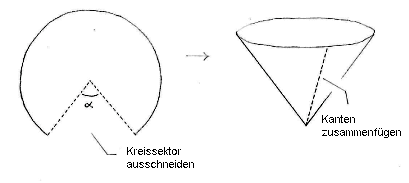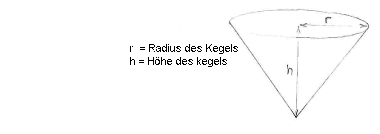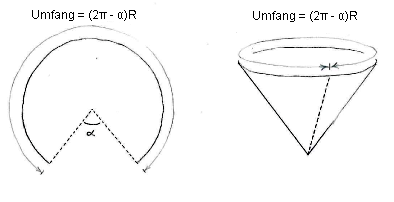Lösung 1.3:7
Aus Online Mathematik Brückenkurs 2
| Zeile 60: | Zeile 60: | ||
::Maximiere <math>V(x) = \frac{1}{3}\pi R^3x^2\sqrt{1-x^2}\ </math> , für <math>0\le x\le 1\,</math>. | ::Maximiere <math>V(x) = \frac{1}{3}\pi R^3x^2\sqrt{1-x^2}\ </math> , für <math>0\le x\le 1\,</math>. | ||
| - | Wenn <math>x=0</math> oder <math>x=1</math> ist, ist das Volumen null. Weil die Funktion überall (außer in <math>x=1</math>) differenzierbar ist, nimmt das Volumen sein Maximum | + | Wenn <math>x=0</math> oder <math>x=1</math> ist, ist das Volumen null. Weil die Funktion überall (außer in <math>x=1</math>) differenzierbar ist, nimmt das Volumen sein Maximum an einer stationären Stelle an. |
Wir leiten die Funktion ab | Wir leiten die Funktion ab | ||
| Zeile 74: | Zeile 74: | ||
\end{align}</math>}} | \end{align}</math>}} | ||
| - | Die Ableitung ist null, wenn <math>x=0</math> (dies ist ein Randpunkt) oder wenn <math>2-3x^2=0</math> ist, also wenn <math>x=\sqrt{2/3}\,</math>. ( | + | Die Ableitung ist null, wenn <math>x=0</math> (dies ist ein Randpunkt) oder wenn <math>2-3x^2=0</math> ist, also wenn <math>x=\sqrt{2/3}\,</math>. (Die Stelle <math>x=-\sqrt{2/3}</math> liegt außerhalb des Gebietes <math>0\le x\le 1</math>.) |
Durch eine Vorzeichentabelle erhalten wir die Vorzeichen der Faktoren | Durch eine Vorzeichentabelle erhalten wir die Vorzeichen der Faktoren | ||
| Zeile 137: | Zeile 137: | ||
|} | |} | ||
| - | Wir sehen hier, dass <math>x=\sqrt{2/3}</math> ein globales Maximum | + | Wir sehen hier, dass die Funktion an der Stelle <math>x=\sqrt{2/3}</math> ein globales Maximum hat. <math>x = \sqrt{2/3}</math> entspricht dem Winkel <math>\alpha</math>: |
{{Abgesetzte Formel||<math>\sqrt{\frac{2}{3}}=\frac{2\pi-\alpha }{2\pi}\quad \Leftrightarrow\quad \alpha = 2\pi \bigl(1-\sqrt{2/3}\,\bigr)\ </math>}} | {{Abgesetzte Formel||<math>\sqrt{\frac{2}{3}}=\frac{2\pi-\alpha }{2\pi}\quad \Leftrightarrow\quad \alpha = 2\pi \bigl(1-\sqrt{2/3}\,\bigr)\ </math>}} | ||
Aktuelle Version
Wie der Kegel gebaut wird, ist hier illustriert.
Da wir das Volumen des Kegels maximieren wollen, betrachten wir nun die Abmessungen Kegels.
Mit diesen Abmessungen ist das Volumen des Kegels
| \displaystyle \begin{align}
V &= \frac{1}{3}\text{(Fläche des Kreises)}\cdot\text{(Höhe)}\\[5pt] &= \frac{1}{3}\pi r^{2}h\,\textrm{.} \end{align} |
Wir müssen jetzt den Radius \displaystyle r und die Höhe \displaystyle h durch den Winkel \displaystyle \alpha ausdrücken, sodass wir das Volumen \displaystyle V als Funktion von \displaystyle \alpha schreiben können.
Schneiden wir einen Kreissektor mit dem Winkel \displaystyle \alpha aus dem Kreis, ist der Umfang des übriggebliebenen Kreissegments \displaystyle (2\pi-\alpha)R, wobei \displaystyle R der ursprüngliche Radius ist.
Der Umfang des oberen Kreises ist aber auch \displaystyle 2\pi r, also haben wir
| \displaystyle 2\pi r = (2\pi-\alpha)R\quad\Leftrightarrow\quad r = \frac{2\pi -\alpha}{2\pi}\,R\,\textrm{.} |
Jetzt haben wir den neuen Radius \displaystyle r als Funktion des Winkels \displaystyle \alpha und des ursprünglichen Radius \displaystyle R ausgedrückt.
Um die Höhe zu bestimmen, benutzen wir den Satz des Pythagoras.
Also haben wir
| \displaystyle \begin{align}
h &= \sqrt{R^2-\Bigl(\frac{2\pi-\alpha}{2\pi}\,R\Bigr)^2}\\[5pt] &= \sqrt{R^2-\Bigl(\frac{2\pi-\alpha}{2\pi}\Bigr)^2R^2}\\[5pt] &= R\sqrt{1-\Bigl(\frac{2\pi-\alpha}{2\pi}\Bigr)^2}\,\textrm{.} \end{align} |
Jetzt haben wir den Radius \displaystyle r und die Höhe \displaystyle h als Funktionen von \displaystyle \alpha und \displaystyle R geschrieben. Das Volumen des Kegels ist also
| \displaystyle \begin{align}
V &= \frac{1}{3}\pi r^2 h\\[5pt] &= \frac{1}{3}\pi \Bigl(\frac{2\pi-\alpha}{2\pi}R\Bigr)^2 R\sqrt{1-\Bigl( \frac{2\pi-\alpha}{2\pi}\Bigr)^2}\\[5pt] &= \frac{1}{3}\pi R^3\Bigl(\frac{2\pi-\alpha}{2\pi}\Bigr)^2 \sqrt{1-\Bigl(\frac{2\pi-\alpha}{2\pi}\Bigr)^2}\,\textrm{.} \end{align} |
Unser Problem ist jetzt:
- Maximiere \displaystyle V(\alpha) = \frac{1}{3}\pi R^3 \Bigl(\frac{2\pi-\alpha}{2\pi} \Bigr)^2\sqrt{1-\Bigl(\frac{2\pi-\alpha}{2\pi}\Bigr)^2}\,, wo \displaystyle 0\le \alpha \le 2\pi\,.
Bevor wir anfangen die Funktion abzuleiten, sehen wir, dass der Winkel \displaystyle \alpha nur in \displaystyle (2\pi-\alpha)/2\pi-Termen auftritt. Um das Problem zu vereinfachen, können wir das Volumen genauso in Bezug auf die Variable \displaystyle x=(2\pi-\alpha)/2\pi maximieren.
- Maximiere \displaystyle V(x) = \frac{1}{3}\pi R^3x^2\sqrt{1-x^2}\ , für \displaystyle 0\le x\le 1\,.
Wenn \displaystyle x=0 oder \displaystyle x=1 ist, ist das Volumen null. Weil die Funktion überall (außer in \displaystyle x=1) differenzierbar ist, nimmt das Volumen sein Maximum an einer stationären Stelle an.
Wir leiten die Funktion ab
| \displaystyle V'(x) = \frac{1}{3}\pi R^3\cdot 2x\cdot \sqrt{1-x^2} + \frac{1}{3}\pi R^3x^2\cdot\frac{1}{2\sqrt{1-x^2}}\cdot (-2x)\, |
und vereinfachen den Ausdruck, indem wir so viele Faktoren wir möglich herausziehen.
| \displaystyle \begin{align}
V'(x) &= \frac{2}{3}\pi R^3x\sqrt{1-x^2} - \frac{1}{3}\pi R^3x^3\frac{1}{\sqrt{1-x^2}}\\[5pt] &= \frac{1}{3}\pi R^3\frac{x}{\sqrt{1-x^2}}\bigl[ 2(1-x^2)-x^2\bigr]\\[5pt] &= \frac{1}{3}\pi R^3\frac{x}{\sqrt{1-x^2}}(2-3x^2)\,\textrm{} \end{align} |
Die Ableitung ist null, wenn \displaystyle x=0 (dies ist ein Randpunkt) oder wenn \displaystyle 2-3x^2=0 ist, also wenn \displaystyle x=\sqrt{2/3}\,. (Die Stelle \displaystyle x=-\sqrt{2/3} liegt außerhalb des Gebietes \displaystyle 0\le x\le 1.)
Durch eine Vorzeichentabelle erhalten wir die Vorzeichen der Faktoren
| \displaystyle x | \displaystyle 0 | \displaystyle \sqrt{\tfrac{2}{3}} | \displaystyle 1 | ||
| \displaystyle x | \displaystyle 0 | \displaystyle + | \displaystyle + | \displaystyle + | \displaystyle + |
| \displaystyle \sqrt{1-x^2} | \displaystyle + | \displaystyle + | \displaystyle + | \displaystyle + | \displaystyle 0 |
| \displaystyle 2-3x^2 | \displaystyle + | \displaystyle + | \displaystyle 0 | \displaystyle - | \displaystyle - |
und erhalten dadurch das Vorzeichen der Ableitung selbst.
| \displaystyle x | \displaystyle 0 | \displaystyle \sqrt{\tfrac{2}{3}} | \displaystyle 1 | ||
| \displaystyle V'(x) | \displaystyle 0 | \displaystyle + | \displaystyle 0 | \displaystyle - | |
| \displaystyle V(x) | \displaystyle 0 | \displaystyle \nearrow | \displaystyle \tfrac{4}{9\sqrt{3}}\pi R^3 | \displaystyle \searrow | \displaystyle 0 |
Wir sehen hier, dass die Funktion an der Stelle \displaystyle x=\sqrt{2/3} ein globales Maximum hat. \displaystyle x = \sqrt{2/3} entspricht dem Winkel \displaystyle \alpha:
| \displaystyle \sqrt{\frac{2}{3}}=\frac{2\pi-\alpha }{2\pi}\quad \Leftrightarrow\quad \alpha = 2\pi \bigl(1-\sqrt{2/3}\,\bigr)\ |




